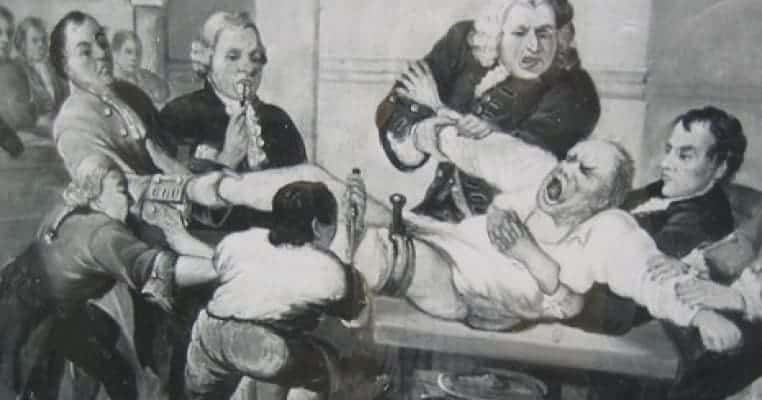Few people get excited about surgery. The thought of having your body cut open so that somebody can stick his or her hands inside will make even the most hardened person shudder. Today, many surgeries can be carried out with minimal invasion and laser targeting. Recovery times are quicker than what they were decades ago, and side effects are drastically lessened nowadays, too. Still, people tend to worry about going under the knife, and historically speaking, they have good reason to be.
Historically, surgery has long been a nasty business. One of the oldest recorded operations was trepanation, a form of lobotomy. During the procedure, a hole would be drilled in the back of the skull to release pressure on the brain and supposedly treat different illnesses. Trepanation was apparently a rather standard procedure. At a gravesite in France dating to 6500 BCE, out of 120 skulls that were uncovered, one-third of them had evidence of undergoing trepanation. Considering that this procedure would have taken place without any anesthesia, except maybe a conk on the head to knock the person out, modern brain surgery seems like a walk in the park.

Alternatively, consider the archaic practice of blood-letting. Ancient Greek doctors, such as Erasistratus, believed that illness was primarily due to an overabundance of different elements in the blood. The solution was to reduce the volume of those elements by causing the person to bleed obsessively. Sometimes, the patient’s skin was cut to induce bleeding. Other times, leeches were applied to the surface. The patient was always at a very high risk of infection, which could be life-threatening. Blood-letting continued to be used throughout the Middle Ages and even in the colonial period of American history.

In the ancient Near East, particularly in Sumer, the common belief was that illness was caused by demonic activity. To qualify as a physician, one had to be able to identify the 6,000 different demons that could be responsible for diseases, with the implicit understanding being that the ability to perform exorcisms was a necessary prerequisite to medical care. For cases when exorcisms failed, the Code of Hammurabi details some surgical procedures that were carried out. Ten shekels were the reward for a surgeon who would successfully remove a tumor over the eye; should he fail to do so and the person died on the table, the surgeon’s hands would be cut off.

Rowan/Wikimedia.
Not all pre-modern surgical procedures were quite as macabre. One of the most successful was the setting of bones that had been broken. The ancient Aztecs developed a method for setting bones that is very similar to modern techniques. Moreover, Julius Caesar, the great Roman emperor, was born via cesarean section – the reason why the common obstetric surgery takes his name – when his mother died during labor. Though his mother was already dead, he survived the surgery and ended up in history books.

